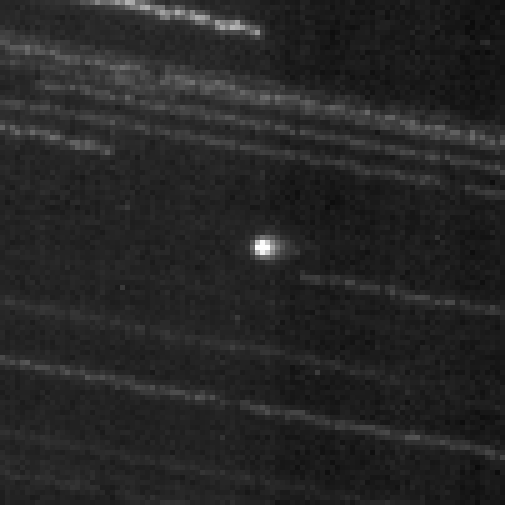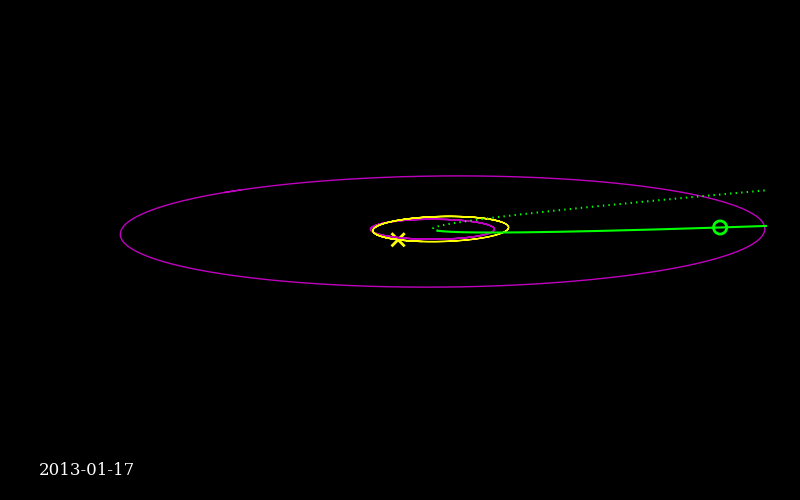EPOXI
Two intriguing investigations -- One flight-proven spacecraft
Gallery
DIF Observes ISON
Comet ISON, just discovered in September 2012, is expected to become more observable by amateurs later this year. As part of an extended observing campaign, the comet was imaged by the Deep Impact Flyby (DIF) spacecraft over a 36-hour period in mid-January while the comet was 5.1 AUs from the sun and 5.3 AUs from DIF. 146 images were collected using a clear filter in the MRI every 15-minutes from Jan 17 03:40 UT to Jan 18 16:20 UT. Scientists have many ways of processing and analysing the images. Here we highlight two ways the 146 images were used. (North is up, East is to the left, and the Sun is to the left.)
Technique 1: Stack and Add

Image 1: This image of comet ISON (C/2012 S1) combines all 146 80-second clear filter exposures for a total integration time of 11680 seconds (about 3.25 hours). Individual frames were shifted to align the comet at the center before coadding. By keeping the comet centered and adding all of the images together, the stars effectively get smeared so the long streaks are the trails of background stars.
Although the comet is 5.1 AU from the Sun and 5.3 AU from the spacecraft, and required a long exposure, it shows a diffuse nucleus and an anti-sunward tail indicating that it is already active. Although the tail appears short and stubby in this image, it is at least 65,000 km long and, due to projection effects, could be significantly longer.
Technique 2: Align and animate
Animation 1: Movie of comet ISON (C/2012 S1) on January 17-18, 2013 as seen from the Deep Impact spacecraft. Here the 146 images are once again aligned on the comet at center. But instead of adding all of the images into one, each image is shown sequentially. The most obvious is the motion of the comet. But by measuring the brightness of the comet in each frame, we can see the brightness of the coma changing by about 6-7% over the course of the sequence.
Formats
+ .mpg (~1MB)
+ .mov (~15MB)
+ .gif (~15MB)
Image 1/Video Credit: NASA/JPL-Caltech/UMD (Tony Farnham)
Comet ISON in relation to DIF, Sun, and Earth

 Image 2: At the time the 146 images were collected, the comet was 5.1 AU from the Sun and 5.3 AU from the spacecraft. Comet ISON's orbit is in green, the location of the comet on Jan 17 is circled, DI's orbit is yellow, X marks DI's spot on the 17th, Earth and Jupiter's orbits are also shown for scale. Comet ISON's orbit is split into pre-perihelion (solid) and post-perihelion (dotted). Top: View of the orbits from above. Bottom: View of the orbits from the side.
Image 2: At the time the 146 images were collected, the comet was 5.1 AU from the Sun and 5.3 AU from the spacecraft. Comet ISON's orbit is in green, the location of the comet on Jan 17 is circled, DI's orbit is yellow, X marks DI's spot on the 17th, Earth and Jupiter's orbits are also shown for scale. Comet ISON's orbit is split into pre-perihelion (solid) and post-perihelion (dotted). Top: View of the orbits from above. Bottom: View of the orbits from the side.
Image 2 Credit: NASA/JPL-Caltech/UMD (Michael Kelley)
Comet ISON background
What sets comet ISON apart from most other comets is that it is a sungrazer, a class of comet that passes very close to the Sun's surface. On November 28, 2013, comet ISON will reach perihelion (its closest point to the Sun) at a distance less than 3 solar radii. Although they are numerous, most comets of this class are very small and faint, and don't survive their close approach to the Sun. Those that do, however, tend to be very spectacular. ISON became active when it was over 5 AU from the Sun (beyond Jupiter's orbit), which means it is different from more typical sungrazers and may have a nucleus large enough to survive its perihelion passage.
Because ISON could potentially become the next "Great Comet", astronomers around the world are planning studies to characterize its behavior leading up to, and hopefully following, its solar passage. Of particular interest will be observations of ISON when it is very close to the Sun where extensive comet studies are rare. NASA is participating in this campaign and the data collected by Deep Impact represent the first spacecraft observations to be obtained in the effort.
Other links
- NASA Science News: Comet of the Century?
- Comet ISON is Coming (M. Kelley's blog)
- SOHO comet movies
- Sungrazing Comets
Related Press Releases
- Comet Debuting in New Deep Impact Movie Expected to Star this Winter
- NASA's Deep Impact Spacecraft Eyes Comet ISON
- Other news items
Where is comet ISON?
Thanks to Ron Baalke at Near Earth Object Program, there is a nifty javascript that shows the current position of comet ISON and the Deep Impact Flyby Spacecraft in relation to the rest of the Solar System.
Orbit Viewer applet originally written and kindly provided by Osamu Ajiki (AstroArts),
and further modified by Ron Baalke (JPL).
original page
If you'd like to check out the interactive orbital displays for other comets and asteroids, please visit the NEO Program.
Where do I look in the sky?
Take a look at Reading an Orbital Diagram to get some basic background on interpreting this graphic and what the sliders and other adjustments do.
